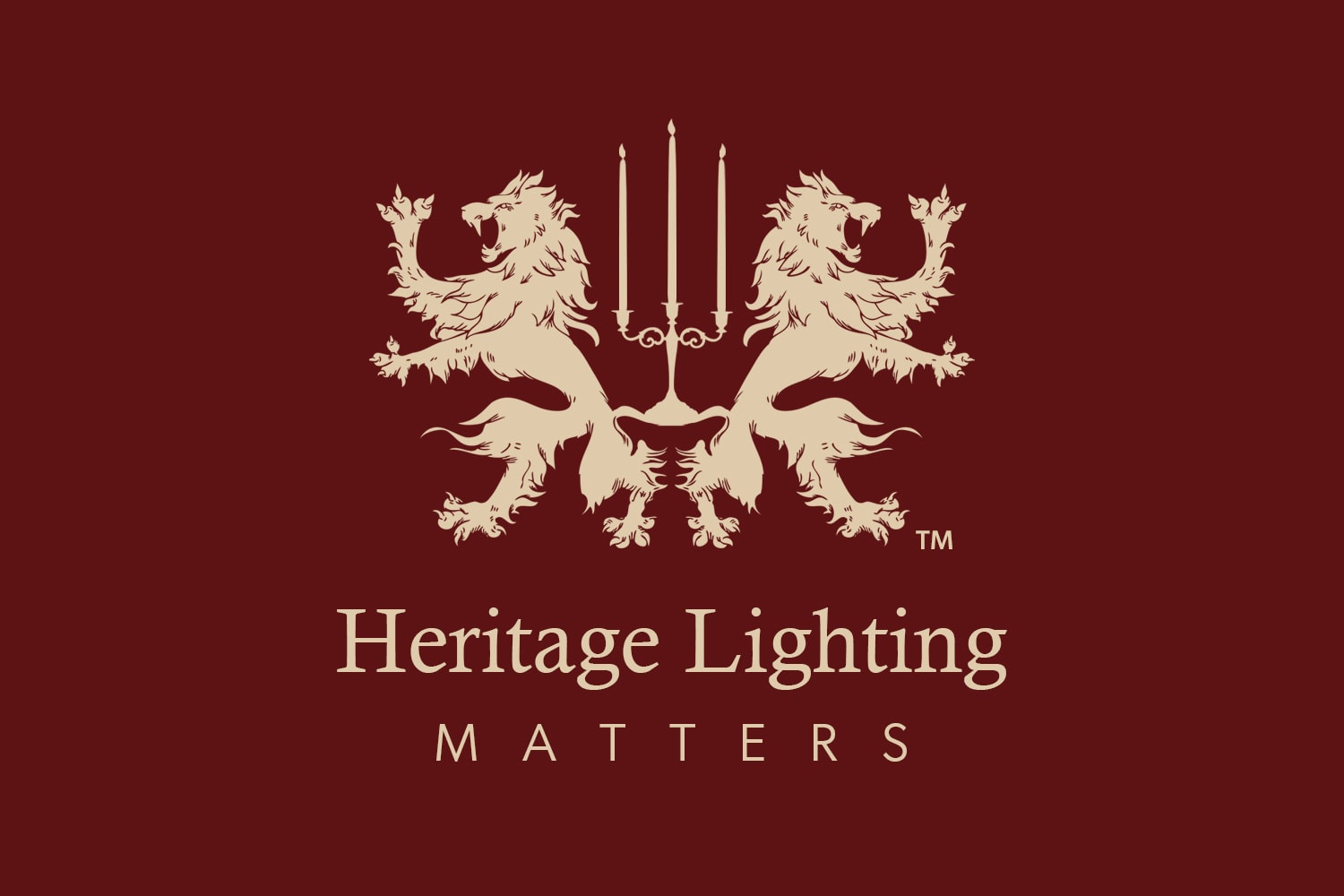

Our client was not happy with the performance of their existing picture lights but didn’t want to throw them away. We offered them an upgrade option to the latest LED technology with our Picture Perfect LED Upgrade Kits allowing them to improve the canvas coverage, reduce your running costs and remove any damaging UV, heat & over illumination at the top of the paintings.
Portrait Details
30” (H) x 25” (W) with a 5” frame
Existing Picture Light
8” head with short arm using a 284mm S15 60W tube lamp
Issue
Over lit at the top with no light on the lower section of the painting. Damaging heat and UV generated at the top of the painting. Lamp replacements frequent & costly. Electricity costs high.
Solution
Removal of the existing lamp & holder to fit our Picture Perfect LED Upgrade Kit.
By fitting our easy to install Picture Perfect LED Upgrade Kit into the existing picture light they were able to gain the following benefits:
· Improved canvas coverage using lensed LEDs
· High CRI warm white lighting to bring out the rich colours & definition across the canvas
· Reduced Energy Consumption (93.3% reduction)
· Removal of damaging heat and UV
· No ongoing lamp changes required for at least the next 10 years
If this would be helpful to you, please let me know. I would be pleased to review your existing lighting and show you how we can transform the lighting of your art collection too. These kits are available in various outputs, lengths & LED numbers to gain the best coverage on the canvas from the existing picture light dimensions that you have.
LED Upgrade Kit Solutions are available to fit in to the following standard picture light sizes:
4” 8” 14” 20” 26” & 32”
Bespoke sizes are also available upon request.
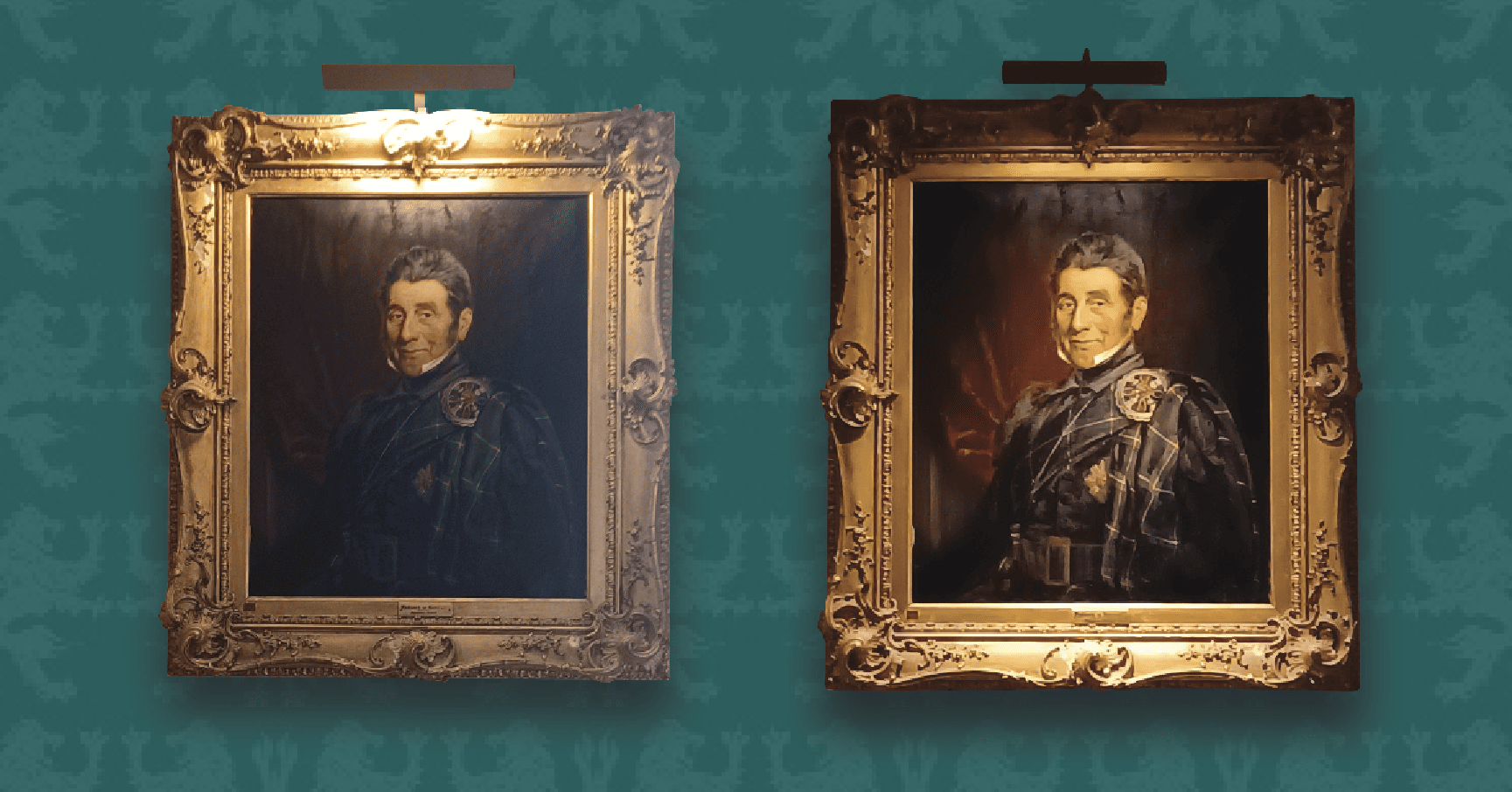
Before and after
When lighting artwork there are many factors to consider to gain the perfect viewing experience and light the entire canvas well. There are various light sources available to do this, however using an adaptable and maintainable lensed LED system is by far the best option. Historically, halogen lamps and tungsten filaments have been used but with the development of LEDs over the last 10 years this is the way to go now.
High CRI lensed LEDS will remove damaging heat and UV whilst extending the life by up to 50X longer, giving a greater coverage, bringing out the richer colours and increasing the texture and definition in your art.
Not all LED Art Lights are the same and I will go through the key points that need to be considered when selecting them.
COLOUR TEMPERATURE
This is very important when lighting art. Most pieces should be lit with a 2700K warm white light to bring out the rich colours within the piece. Cooler colour temperatures can be used, but these are rare.
COLOUR RENDERING INDEX (CRI)
When lighting art you want to use the highest CRI that you can. 98 CRI is currently the highest LED level in the marketplace and will allow the rich reds and blues to show their true colours as well as adding depth and definition to your paintings.
LED LENSING & SPACING
This will be determined by the canvas dimensions with a spacing of up to 10” each with pre-selected lensing as required, from say 15 through to 60 degrees to give a uniform coverage across the canvas. This will remove the points of glare, hotspots and low light levels experienced with older technology. Over illuminated areas will cause long-term damage to your painting.
LIGHTING LEVELS
Dependent on the composition of the art, examples are sketches, water colours, oils, pastels and acrylics, different intensities of light will be required for each. An oil painting should be lit at <200Lux whereas a paper sketch should not exceed 50Lux. These can be controlled by dimming or other screening methods.
PICTURE SURFACE
Artwork can be open to the elements or behind glass (standard or anti-glare). The position and angle of the head can remove all reflective points when lighting a painting with glass.
ART LIGHT HEAD
The width of the head should not be more than 10-12" less than the canvas width to ensure the edges are lit. If it looks too small, it probably is. To the rear of the art light should be a swivel knuckle. This will allow the cowled front to conceal the lightsources from view. Multiple art light heads can be used successfully to light very wide paintings although single heads of up to 120" are available from some suppliers, if required.
PICTURE HEAD STYLE
The two most popular styles are the fixed or variable position LED art lights with the variable giving greatest flexibility and thus a far superior coverage. This will feature a rail system and will allow lensed LEDs to be attached as required to light any canvas size.
ARMS
Properly sized arms are required to position the head at the correct height and projection for the painting.
LED DRIVERS
Careful selection and positioning is required here to ensure the driver runs at a low temperature and doesn’t damage the artwork if attached to the frame.
PICTURE LIGHT COLOURS & FINISHES
Many options are available, and your selection should complement your artwork. To conclude, when art is lit correctly it makes such a difference. There are many options available in the marketplace, but many do not consider all the above details. As you can see it is not easy to light a fine painting well. You need to consider how to cover the entire canvas evenly at the right intensity, not too bright, in the right colour temperature and with the highest colour rendition possible. All these points together will bring out the texture and rich colours in the artwork. Only when fine art is lit correctly can you truly, fully appreciate it. So many clients have told me that although they had looked at a painting for years, had never noticed a feature in the painting such as an animal, a facial expression, or some other hidden gem until it was lit well. This happens all the time and that is why it is so important to light your art correctly. Being able to see all those finer details within your painting will make you appreciate it even more. You don’t have to use art lights to light your art, but if you do, make sure you consider all these points.
If I can be of further assistance in helping you here, please do make contact.
Article written by Iain McIntosh, published in the Listed Heritage magazine issue 147.
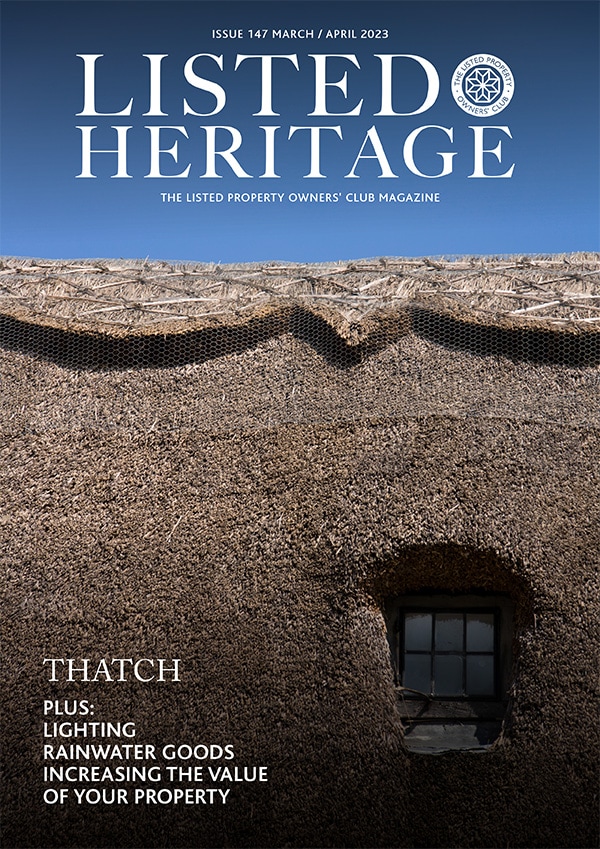
When lighting art it is really important to gain a full canvas coverage and to do this you will need to use a combination of lensed LEDs at pre-determined spaces which will be dictated by the canvas size and orientation. It is important to state that LEDs will not produce damaging UV emissions and when correctly set up will have no damaging heat present either from the LEDs or the LED driver.
This is a really difficult question to answer because there are so many important factors that need to be considered and I will go through these one by one to explain why they are all so important, what the options are and how to avoid any issues in the future.
Colour temperature
When lighting art the colour temperature is so important. Most pieces of art should be lit with a 2700 Kelvin colour temperature to bring out the rich colours within the piece. Other colour temperatures can be used such as 3000 Kelvin and 4000 Kelvin to light paintings and this will be dictated by the colours and subject matter.
Colour rendering index (CRI)
When lighting art you want to use the highest colour rendering index that you can. CRI is measured from zero to 100. Many LEDs have a CRI of about 80. The higher the CRI the better it is for lighting art. 98 CRI is currently the highest LED level in the marketplace and will allow the rich reds and blues to show their true colours as well as adding depth and definition to your paintings. This will make such a difference to your viewing pleasure.
Canvas coverage
To gain a full canvas coverage you will need to use a combination of lensed LEDs. The number, angles and intensities will be determined by the canvas orientation. Some picture lights will not cover the canvas and give high intensity light points, particularly close to the picture light head. These are known as hotspots and will be detrimental to your painting causing a large over illuminated area which will cause irreparable & long term damage to your painting.
Correctly lighting your painting
The way the painting is lit canalso be affected by the materials by which it was created, such examples of these are sketches, water colours, oils, pastels and acrylics and different intensities of light will be required for each. For example an oil painting should never be late a greater than 200 Lux this total is based on 8 hours of illumination each day if we compare that to paper sketch this should be much lower atunder 50Lxover the same periodI set out by conservation standards. These levels can be achieved by reducing the light intensity and can be reached using neutral density filters or by dimming the light levels.
Picture surface
Artwork can be open to the elements or behind glass. The glass can be standard or anti-glare and your picture light will need to factor each of these options into its construction. The position and angle of the head is critical when lighting a painting with glass so that reflective points are removed when viewing your artwork.
Lightsource type
There are many types of lightsource available, but the main two sources today are halogen and LED. LED is by far the lightsource of choice due to its longevity, flexibility, adaptability, and maintainability. Through appropriate lensing full canvas coverage is possible for all canvas dimensions.
LED lensing
Each LED can be spaced to work alongside other LEDs and by using various lensed outputs will give a full canvas coverage. The lenses should be chosen from a selection of say 15, 30, 45 and 60 degrees as well as elliptical versions to give the ultimate cover across the canvas. The spacing and distribution from the LEDs are essential to reach all areas of the canvas. Failure to use correctly lensed LEDs will result in sub-standard lighting especially on larger paintings. A 15 degree lens will give a narrower beam but will reach much further, whereas a 60 degree lens will result in a much wider coverage but not reach as far down the canvas. There is a real art to calculating the number of LEDs, relative positioning in the head and the lenses selected to light a painting correctly.
Dimming
Picture lights can be wired into a non-dimmable supply or can be dimmed. There are many types of dimming protocols available such as dali, mains dimming, 0-10V, 1-10V, Lutron, phase dimming, etc. It is important to select the compatible dimming driver when working with an existing dimming protocol to ensure that the picture light dims successfully.
Reduced illumination without dimming
The insertion of a neutral density film can be positioned to the front of the lensed LED. It will not change the colour temperature or CRI but will reduce the light intensity. Very few companies allow for this when it is required. Over illumination can affect your artwork and it is important to protect against this.
Picture light head
To gain full canvas coverage the size of the head is essential. If the head is too small you will only be able to light the central section of the painting leaving the outer areas unlit. If you take the width of the canvas and subtract 4 inches from the left and four inches from the right side this will give you the width that the head should be. To the back of the picture light should be a swivel knuckle to allow overall positioning above the painting. So, as you can see, each head needs to be individually calculated to give best coverage across the canvas. Head sizes start at 2 inches and increase at 2 inch increments up to 60 inches as standard. For extremely large paintings further sizes are available of up to 120 inches. Alternatively, multiple picture light heads can be used successfully and overcome the issue of transportation. With respect to positioning of two heads on the same painting, there needs to be a gap between them and this needs to be calculated correctly to ensure over or under illumination is not experienced.
Picture head style
The two most popular styles of LED picture lights are the fixed and the variable position art lights and careful consideration is needed here to ensure that you select the model best suited to your specific needs.
Fixed Art Lights
This style has lensed LEDs mounted in fixed positions at pre-set points along the width of the head and can give a very good canvas coverage when set up correctly. To ensure artwork is not over lit it is important to ensure that the spacing between the LEDs is not too close (less than 5 inches could give too much illumination). As the LED positions are pre-set and fixed the head width and height can be very compact in size.
Variable Art Lights
This style is maintainable and adjustable and allows you to select and position your lensed LEDS on a rail as required to give a full and uniform canvas coverage across the painting surface. As the LEDs are positioned along the rail, they will have a secondary tilt action to give even better positioning and coverage. The head size will be larger to accommodate this added flexibility but will still be in keeping with the painting.
Arms
There are two standard styles of arms; the classic arm and the straight arm. The arms are sized along with the head to Position it correctly. The classic arms should come in 3 standard sizes small, medium, and large as well as in bespoke sizes where required. The straight arms would be attached to the wall using either a round wall mount or a square wall mount. The arms connect to the head via a swivel knuckle and should have a 90 degree adjustment to allow for an external tilt to the head. The standard arms should be either attached to the back of the frame or to the wall. This can be by personal preference or dictated by the environment the art is in. Picture lights can come with 1 or 2 arms and manufacturers overall offer a single arm up to a certain length and then switch over to 2 arms at a certain length. I have found that a width of 26” or larger is the best range for 2 arms.
LED drivers
It is important to select the correct size of the LED driver to power the picture light. the driver will need to be large enough in output to run the total number of LEDs in the head plus some extra capacity. This extra capacity is essential to ensure that the driver does not become too hot and damage either the frame or the painting. If there is too much excess capacity available, you will experience certain issues such as flickering or failure to switch on. Many drivers are available but careful selection is required. The following points need to be considered when selecting a driver; minimum & maximum wattage in relation to the total LED requirement, constant current or constant voltage output, the physical dimensions, the operating temperature & where it is to be positioned in relation to the painting.
Maintenance & Adaptability
As technology develops in the future the variable art lights will be able to respond to changes and can be upgraded quickly and easily, retaining the main parts, and keeping the costs to a minimum.
Picture Light Colours and Finishes
There are many types of finish available such as Polished Aluminium, Polished Brass, Satin Brush Steel, Satin Brushed Brass, Architectural Bronze, Antique Bronze and specific RAL colours applied to an Aluminium head and arms. The most popular by far (>95% of sales experienced) is Classic Old Gold paint on aluminium.
Installation
This will be the subject of a separate blog. I will be developing an installation guide to allow you to carry out your own installations yourself or using a local trusted contractor to keep your costs to a minimum. Installation does not have to be complicated and a simple guide will help to keep your costs under control. Where complex installation is required the use of a specialist team should be used.
Summary
When art is lit correctly it makes such a difference. There are many options available in the marketplace but many do not consider all of the above details. As you can see it is not that easy to light a fine painting well. You need to consider how to cover the entire canvas evenly at the right intensity, not too bright, in the right colour temperature (in most instances 2700 Kelvin but not always) and with the highest colour rendition possible. All these points together will bring out the texture and rich colours in the artwork. Only when fine art is lit correctly can you truly fully appreciate it.
So many clients have told me that although they had looked at a painting for years, had never noticed a feature in the painting such as an animal, a facial expression, or some other hidden gem until it was lit well. This happens all the time and that is why it is so important to light your art correctly. Being able to see all those finer details within your painting will make you appreciate it even more.
So, onto the subject of price now
This is a very difficult question to answer because all pieces of art are different and so need to be treated differently. It is very difficult to give a standard price for any painting. I would, however like to give you an indication of some prices that are available for 4 popular portrait sizes using a non-dimmable picture light, in a classic old gold paint finish, complete with classic arms and ready for installation from our Picture Perfect Ranges.
Painting Dimensions | Picture Perfect Art Lights | |||||
Size | Height | Width | Frame | Supreme | Classic | Mini |
Small Portrait | 20” | 14” | 1" | £340 | £260 | £240 |
1/4 Portrait | 30” | 26” | 2" | £505 | £365 | N/A |
1/2 Portrait | 50” | 40” | 3" | £745 | £470 | N/A |
Full Portrait | 90” | 60” | 4" | £1,120 | £675 | N/A |
Picture Perfect Supreme Art Lights - Variable position with High CRI Lensed LEDs
Picture Perfect Classic Art Lights - Fixed position with High CRI Lensed LEDs
Picture Perfect Mini Art Lights - Miniature Head with a single High CRI Lensed LED
Other types of art lighting are available such as remote art lighting from Fibre optic Light Systems, LED Track Lighting, and recessed or surface mounted LED Lighting. They can offer either a framed or soft focused effect across the canvas. These may be appropriate for certain applications and should be considered. If you require details on any of these other options, please let me know and I would be pleased to detail some points to consider if it would be helpful.
If you still have any questions or would like a specific price for a piece of artwork that you have, please do contact me directly, I would be pleased to cost this for you and help you light it correctly.
Take a look at the black and white painting below with just 1 red tree to illustrate the effect. Each time it is lit with a 2,700K lamp but the colour rendering increases from 80 to 98. The red colour changes dramatically as the CRI increases, but also the texture and definition improves giving a completely different feeling to the painting. This is the colour rendition and many low quality LEDs have a CRI of only 80. To light your art correctly you should select the highest level CRI possible to bring out the true rich colours, textures and definition of the artwork.
Look how it changes with increasing CRI and the huge difference between the 98 & 80 CRI images.
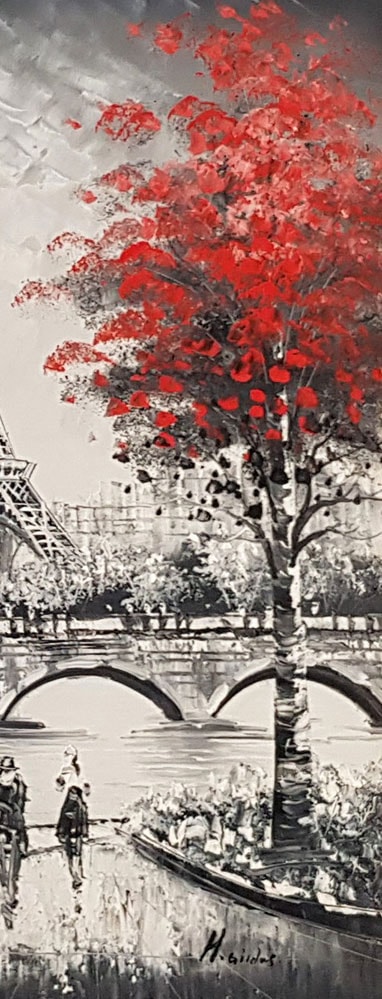
2,700K CRI 90
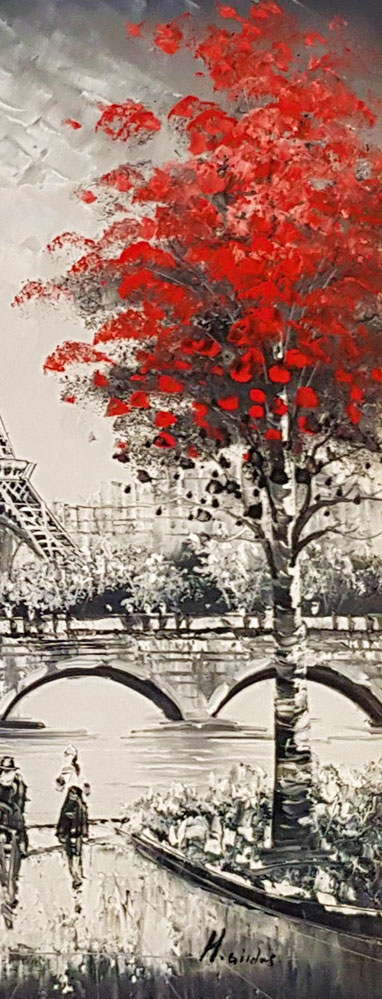
2,700K CRI 95
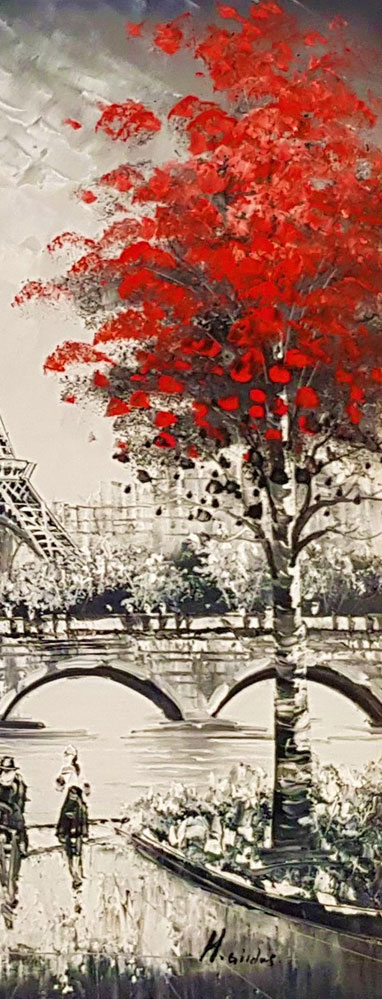
2,700K CRI 98

2,700K CRI 80
This is the colour of the light and is measured in degrees Kelvin (K). The lower the number the warmer the colour. As it increases the white light becomes colder. Most paintings benefit from Warm White light, specifically 2,700K, however, this is not always the case. Examples of the ranges are detailed below:
1,800K Candle Light
2,000K – 2,400K Extra Warm White
2,700K – 3,200K Warm White
3,600K – 4,200K Natural White
4,600K – 5,500K Cool White
5,600K – 6,400K Daylight White
6,600K – 7,500K Ultra Daylight
Colour Temperature Scale (K)

To light your art work correctly you will need to consider each of the following points: | |
Colour temperature | 2,700K, 3,000K, 4,000K |
Colour rendering | As high as possible we work with RA 98+ (the highest in the market for LEDs) |
Canvas coverage | Full with no hot spots |
Picture type | Sketch, watercolour, oil, pastel, acrylic |
Picture surface | Open or behind glass |
Lightsource | Halogen, LED |
Lightsource life | 1,000 – 50,000 Hrs |
Lightsource type | Fixed or adjustable, Modular or lamp |
Head finish & colour | PA, PB, SS, SB, CG, AB, ANB, RAL colours or anodised plate finishes* |
Head size | Bespoke sizing for canvas dimensions |
Light levels (inc. UV) | To meet curatorial & conservational requirements |
Dimming | Dali, 0-10V, 1-10V, Lutron or Phase |
Temperature control levels | To meet curatorial & conservational requirements |
Attachment points | To wall or back of frame |
Arm lengths | Short, medium, long or custom |
Arm style | Classic, traditional, straight or custom |
Maintenance | Easy to adjust and simple to detach (if required) |
Remote Lighting | Via a framed or soft focused spotlight, track light or fibre optic lighting system |
* Finish options: PA Polished Aluminium PB Polished Brass SS Satin Brushed Steel SB Satin Brushed Brass CG Classic Old Gold ARB Architectural Bronze ANB Antique Bronze BK Black WH White Other finishes available.

The creation of a full asset list detailing all of your lighting applications by type and location. The best option to replace each light will be recommended along with the following key information necessary to review which improvements should be prioritised:
| Payback period | Short-term | Mid-term | Long-term |
| Timescale | < 24 months | 24 - 60 months | > 60 months |
| Lightsources reviewed | Lamps, Fittings, Art Lights & Fibre Optic Systems | ||
The following estimations are based on 8 hours a day, 5 days a week for 50 weeks a year with an electricity cost of 15p/kWhr.
Example of some lamps | ||||
40W Candle | 60W GLS | 15W Mini Candle | 50W GU10 | |
Total Year 1 Savings* | £14.80 | £20.33 | £23.24 | £17.13 |
Lamp Life (25,000Hrs+) years | 12.5 | 12.5 | 12.5 | 12.5 |
Lamp Life Savings | £185.00 | £254.13 | £290.50 | £214.13 |
Breakeven Point months | 6.1 | 2.9 | 6.5 | 5.3 |
Return on Investment | 24.7 | 51.3 | 23.2 | 28.6 |
* - made up from electricity savings, cost to replace failed old lamps, time to change lamps and a reduced CO2 levy
Information gathered at the time of survey
Information presented
Report overview information
Change Over Program
Individual changes prioritised in order of Breakeven Point (traffic light system)
Costs for the complete changeover to our LED range throughout the surveyed property